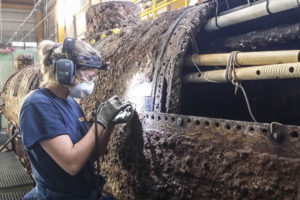According to the scientists studying the submarine, the crew did not operate the emergency keel release mechanisms the night they lost their lives in the experimental, 40-foot vessel. The keel blocks will join public display starting this Saturday, July 20th during weekend tours. The blocks represent a significant breakthrough in conservation as well as an important clue for those working to solve the mystery of the Hunley’s disappearance.
Background
In 1864, the Hunley became the world’s first successful combat submarine with the sinking of the USS Housatonic. Historical records indicate the submarine’s crew signaled to shore they were on the way back home but instead they vanished without a trace. The reason surrounding the Hunley’s loss has remained an intriguing maritime mystery for over a century.
Many theories have circulated over the years to explain the final moments that resulted in the death of her eight-man crew. A popular theory is the Hunley got stuck on the sea bed, unable to rise. Cranking the submarine over 4 miles to their target would have been physically exhausting to the crew. To ease the stress, they planned their approach with the outgoing tide. It is possible they waited on the bottom of the ocean floor for the tides to turn so they could use the current to help get back home. If they somehow got stuck, they likely would have attempted to drop some of the heaviest keel blocks to help rise back up to begin the journey back to land. However, the blocks were found fastened in place, meaning they did not attempt to use this emergency function. For some reason, the crew did not think it would help or were unable to start this emergency procedure.
How the Keel Emergency Release Worked
The keel is made up of eight separate cast iron pieces, with a few of them weighing over 500 pounds. While they provided center-line weight for the submarine, they could also be dropped if she became stuck underwater. By using a turnkey function inside the crew compartment, three of the keel weights could be quickly released. This would enable the crew to drop over 1,000 pounds of weight in the event they were struggling to come back up after a dive.
“The Hunley designers thought about problems that might arise and I think they understood the need for contingency plans. The keel blocks are a perfect example of the many innovative design features we see installed on the submarine,” said Michael Scafuri, a Clemson Archaeologist working on the Hunley Project.
This particular emergency function was not used. The question scientists must now answer is why. Studies of the human remains show no new injuries to the crew and no signs of panic, suggesting that they did not know they were in trouble until it was too late.
Watch a video about the keel blocks.
About the Keel Blocks
The ability to stay upright is a fundamental requirement of any seafaring vessel. It is quite literally a matter of life and death. The Hunley, as one of the world’s earliest functioning submarines, was no different. The keel provided center-line weight helping the submarine’s overall stability and stopped her from rolling while she travelled through the ocean waves.
The Hunley’s keel blocks had to be removed before conservation could begin on the submarine’s pump system. They have now been carefully preserved after a long, multi-year treatment in a chemical solution. The new exhibit will teach visitors about the block’s conservation and use on the submarine.
Images of the keel block conservation.
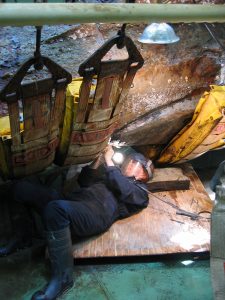
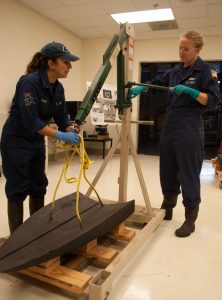
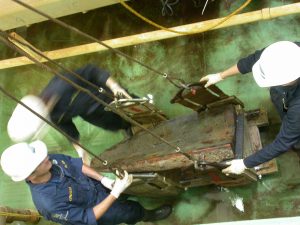
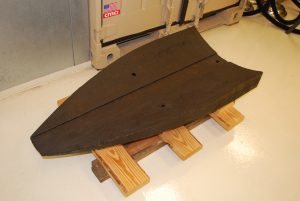
The Hunley Project
On the evening of February 17, 1864, the H. L. Hunley became the world’s first successful combat submarine by sinking the USS Housatonic. After signaling to shore that the mission had been accomplished, the submarine and her crew of eight mysteriously vanished. Lost at sea for over a century, the Hunley was located in 1995 by Clive Cussler’s National Underwater and Marine Agency (NUMA). The innovative hand-cranked vessel was raised in 2000 and delivered to the Warren Lasch Conservation Center, where an international team of scientists are at work to conserve the submarine for future generations and piece together clues to solve the mystery of her disappearance. The Hunley Project is conducted through a partnership with the Clemson University Restoration Institute, South Carolina Hunley Commission, Naval History and Heritage Command, and Friends of the Hunley.



